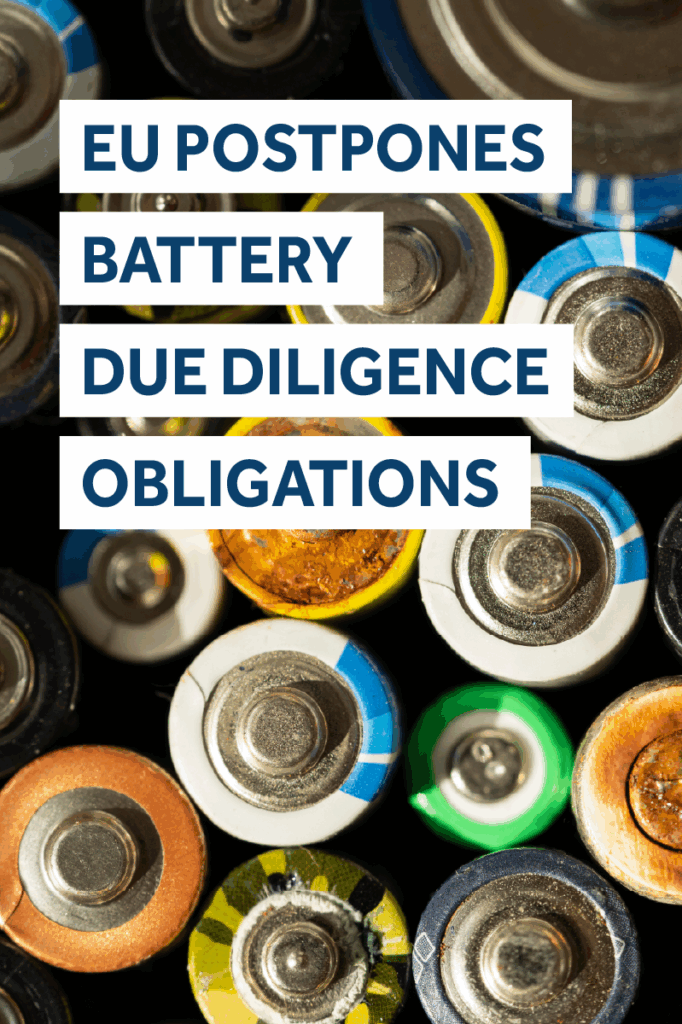EU Battery Regulation
September 3, 2025 | Written by GreenSoft Technology, Inc.
EU Postpones Battery Due Diligence Obligations to 2027

EU publishes amendment to postpone EU Battery Regulation due diligence obligations
On 30 July 2025, the European Commission published Regulation (EU) 2025/1561 in the Official Journal, amending the EU Battery Regulation (Regulation (EU) 2023/1542) to postpone the implementation of key due diligence requirements.
The due diligence provisions, which were originally scheduled to apply starting 18 August 2025, will now take effect on 18 August 2027. These rules cover the responsible sourcing, processing, and trading of cobalt, natural graphite, lithium, and nickel—critical raw materials used in the manufacturing of batteries.
Why the postponement?
The European Commission explained that the postponement will give both regulators and industry additional time to prepare for compliance with the new obligations. Many stakeholders had raised concerns that the original timeline was too ambitious, particularly given the complex supply chains involved in battery production.
In addition, the deadline for the European Commission to publish the official due diligence guidelines has also been extended. Originally required by 18 February 2025, the guidelines are now expected by 26 July 2026—more than a year later than initially planned.
What this means for electronics manufacturers
For electronics manufacturers, the two-year postponement provides additional time to prepare for compliance, but it should not be seen as a reason to pause progress. Many electronics products rely on batteries containing cobalt, lithium, nickel, and natural graphite, which means that due diligence obligations will directly impact their supply chains.
This delay gives manufacturers the opportunity to:
- Map battery use across product lines and determine which models will trigger due diligence requirements.
- Engage suppliers to start gathering data on the sourcing and processing of raw materials used in embedded batteries.
- Integrate due diligence systems into existing compliance processes, such as those already in place for EU RoHS, REACH, or Conflict Minerals reporting.
- Align procurement policies with upcoming EU guidelines to avoid last-minute disruptions once enforcement begins.
Next Steps
- Start early supply chain engagement: Use the extra time to build relationships with battery suppliers and request sourcing data now.
- Prepare internal systems: Ensure your compliance teams and tools are capable of handling due diligence reporting requirements.
- Leverage cross-regulation synergies: Coordinate due diligence efforts with other regulatory frameworks that also target supply chain transparency.
- Monitor EU developments: Keep track of the European Commission’s due diligence guidelines, now due by July 2026, as they will shape the exact reporting framework.
Identifying hazardous substances in products
GreenSoft Technology, Inc. provides Data Services and GreenData Manager software to help companies identify the presence and amounts of hazardous substances in their products, including Mercury, Cadmium, and Lead.
Our data collection team will contact your suppliers on your behalf to obtain data on the substances contained in your products and components, and validate that data for completeness and accuracy.
We’ll provide reports in a variety of formats, or generate reports yourself using GreenData Manager software, so that you can easily show compliance with the EU Battery Regulation and other global environmental regulations.
Contact us to learn more, or get started now with a free online BOM Scrub/Project Timeline Estimate.

